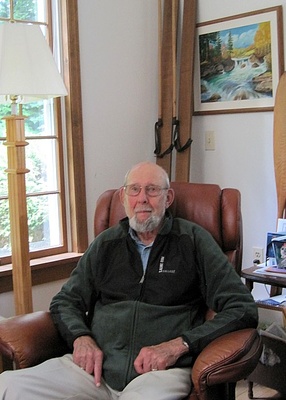 David Hanning
David Hanning
Photograph courtesy of Kurt PetersonDave Hanning was born in 1927 in Saranac Lake where his dad came to cure, dividing his early years between summers in Saranac Lake and winters in Montreal where his mother was a private duty nurse for wealthy families. Because of anti-American feelings in Canada--the U.S. had not yet entered WW II in support of Canada and England--Dave's family returned to Saranac Lake full time when Dave entered 8th grade. He describes an idyllic childhood with "little parental supervision:" climbing in the old quarry on Baker, sledding on Moody Pond, riding the horse-drawn sleigh to the ice house and roaming the woods with his .22-gauge rifle from age 9. First jobs included work at the Enterprise, and boxing groceries at the A & P for delivery by Eddie Norman in his Model A panel truck as few people had cars. As all the men were away at war, Dave and friend Charlie Sporck also life guarded the summer before high school graduation at the village beach.
Drafted 12 days after high school in 1945, Dave was sent to Yale after Basic Training to learn Japanese and served as a translator in Japan during the occupation. After being discharged from the Army he and Charlie attended Paul Smith's, paying their tuition by rebuilding wrecked cars and selling them to dealers. Dave also worked for the Conservation Department summers, getting to know Noah John Rondeau, whom he describes as "well spoken and well read," and sharing lunch with Noah at his cabin in the woods.
Following Paul Smith's, Dave attended St. Lawrence University on a ski scholarship--he helped lay out the Paul Smith's ski slope on Jenkins Mountain--graduating in 1951 with a liberal arts degree. Moving to Rochester he landed a job with Kodak as a standards engineer though he did not have an engineering degree, his summer jobs serving him in good stead. He also served 40 years at Bristol Mountain on ski patrol while in Rochester. Returning to the Saranac Lake of his youth, Dave remarks on the wonderful diversity of professions, ethnicities, and religions reflective of the cure patients drawn from around the world, all getting along without the racial and ethnic tensions we sometimes encounter today.
Summary by Kirk Peterson, who interviewed David Hanning in September of 2014.



